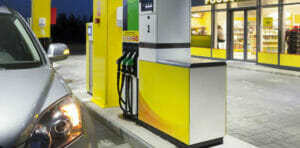There’s a correlation between increases in gas prices and electric car sales and a decrease in dollars spent at the pump.
So, how can convenience stores make up for the lost revenue from that segment of the business? It means they can’t just focus on gas anymore.
To combat these trends, convenience store chains and store operators need to be future-focused, investing in programs that will help them be successful long-term. This shift means that convenience store operators need to become better merchandisers within the stores and place greater emphasis on foodservice offerings.
NACS, the Association for Convenience and Petroleum Retailing, indicates that the growth in foodservice can be attributed to two primary drivers: 1) more and more time-starved consumers want on-the-go meal solutions, and 2) retailers have found that foodservice can deliver new customers inside the store, and at a higher profit level than for items like gas.
The revenue streams for convenience stores are shifting, with foodservice providing the greatest profitability, followed by beverages, then tobacco. In fact, the margin on non-foodservice items in c-stores is 27 percent, while foodservice generates a 57 percent margin, according to a presentation on foodservice at the NACS Show 2016.
So, as convenience stores think about their competition, they shouldn’t just look across the street at another gas station, but start looking down the road to fast food restaurants, as well.
“Those that are leading the c-store foodservice industry segment see themselves as restaurants that just happen to sell gas,” said Ted Asprooth, new business development manager for Antunes’ convenience store segment.
Convenience stores do have an obvious advantage over QSRs — they have a captive audience already visiting their stores to pump gas. If operators can convert gas-only customers into ones that purchase beverages and food from their facilities, the impact on their businesses will be significant.
It’s already happening. According to a Technomic Retailer Meal Solutions (RMS) Consumer Trend Report, 62 percent of RMS consumers purchase prepared foods from c-stores – representing a 10-point rise over the five years prior to the survey.
“Foodservice can serve as a differentiator,” said Asprooth. “Every store is going to offer Coca-Cola and M&M’s, but it’s your foodservice offering, especially for the breakfast daypart, that is critical.”
To best capitalize on these growth and revenue opportunities, convenience store leaders need to partner with companies that understand the market and can provide viable solutions as they look to improve their menus and meet consumer needs.
As a leading equipment manufacturer, Antunes creates custom water filtration and countertop cooking equipment that is well suited for the convenience store market.
Water filtration is important to c-stores because it can enhance the taste and quality of water used for coffee, iced tea fountain drinks, as well as in ice machines. Additionally, as operations look to enhance their breakfast programs — particularly breakfast sandwiches, which are key in this market — Antunes’ Egg Station with Dual Zone enables operators to easily serve freshly cooked eggs to customers on demand using the two independent cooking zones. This unit is perfect for convenience store locations with menu items that require cooking fresh eggs throughout the day and those with the need to cook smaller or single batches of eggs on demand.
See how Antunes assisted a regional convenience store chain with their water filtration needs, improving the taste of the water and lowering the total cost of ownership.


 Trends and Toasting: Flatbreads, Tortillas and Wraps
Trends and Toasting: Flatbreads, Tortillas and Wraps